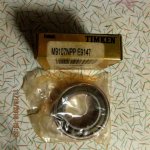LabTechLuke
Plastic
- Joined
- Nov 18, 2019
Hello all.
Long time reader of the forums... I finnaly signed up for an account so I can talk and be apart of the conversation.
Nice to meet you all! ANYWAYS!
ANYWAYS!
I need some help. I work at a college machine shop and I have 9 J-Head Bridgeports in my shop... this last semester I've noticed the students complaining about the draw-bars heating up. sometimes there's some "weird sounds" or vibration in the bar when it is slowing down. It also seems to always be the same few machines that have this issue.
When this happens I would pull the draw bar out of the machine and inspect it. other than being hot, nothing looks wrong. I have oiled the bar and put it back... sometimes that fixes the issue. other times I have replaced the draw-bar and that has fixed the issue. but it seems to be coming back every so often.
In all my years running Bridgeports (9 years) I've never had this happen to me.
Is it possible that there is something else going on with the machines? could it be operator error? (I make sure they aren't over tightening the draw bar...)
Has anyone seen this before?
I've been keeping up on preventive maintenance... but I don't have much repair experience.
Thanks for any help!
-Luke
Long time reader of the forums... I finnaly signed up for an account so I can talk and be apart of the conversation.
Nice to meet you all!
 ANYWAYS!
ANYWAYS!I need some help. I work at a college machine shop and I have 9 J-Head Bridgeports in my shop... this last semester I've noticed the students complaining about the draw-bars heating up. sometimes there's some "weird sounds" or vibration in the bar when it is slowing down. It also seems to always be the same few machines that have this issue.
When this happens I would pull the draw bar out of the machine and inspect it. other than being hot, nothing looks wrong. I have oiled the bar and put it back... sometimes that fixes the issue. other times I have replaced the draw-bar and that has fixed the issue. but it seems to be coming back every so often.
In all my years running Bridgeports (9 years) I've never had this happen to me.
Is it possible that there is something else going on with the machines? could it be operator error? (I make sure they aren't over tightening the draw bar...)
Has anyone seen this before?
I've been keeping up on preventive maintenance... but I don't have much repair experience.
Thanks for any help!
-Luke






